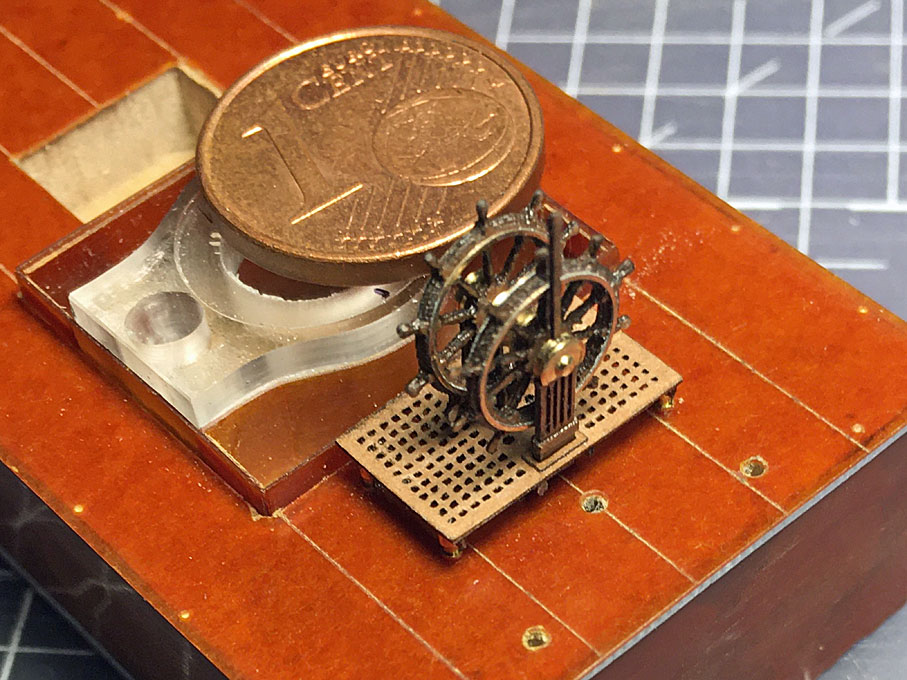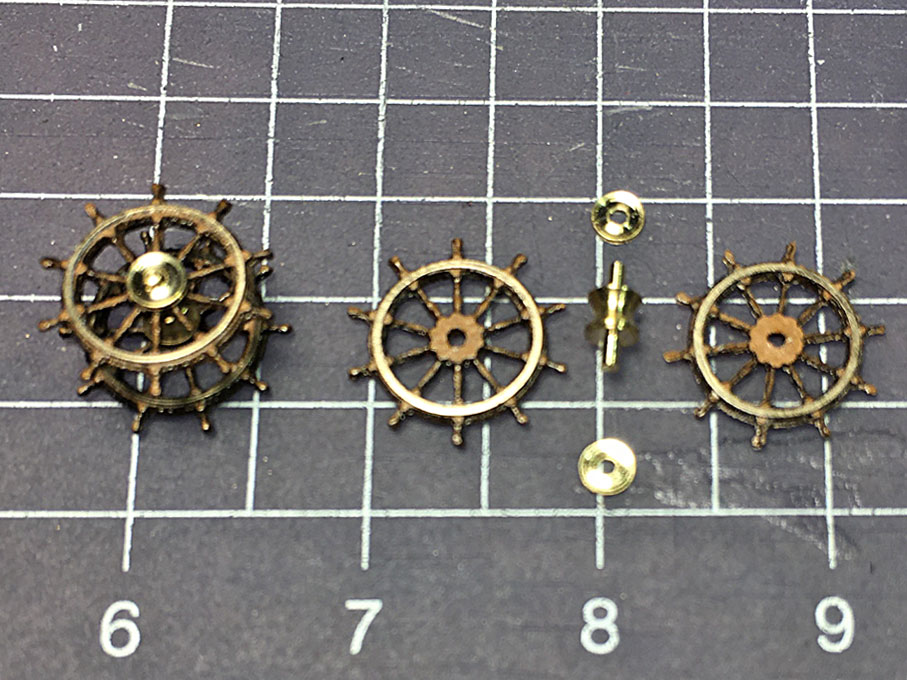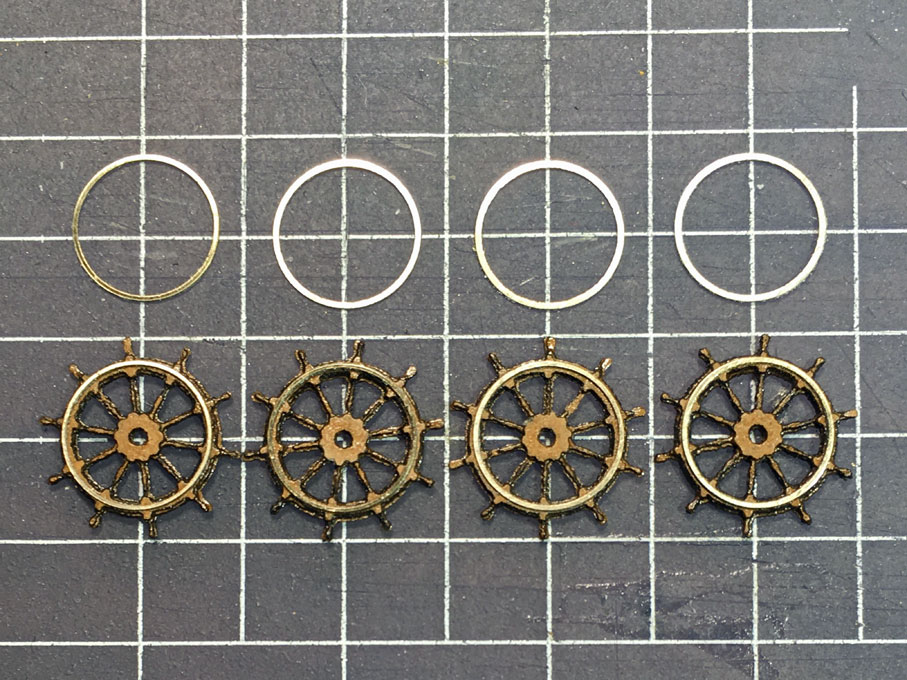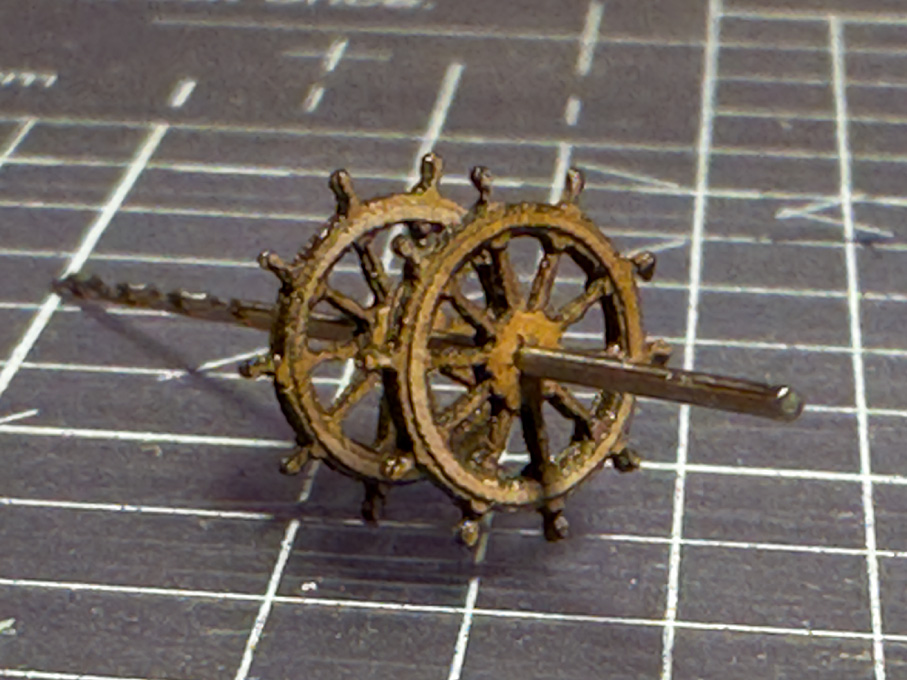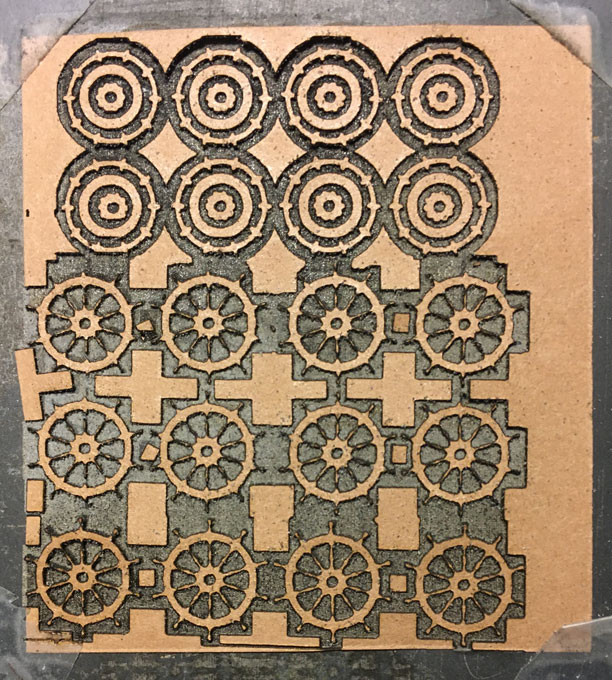-
Posts
6,642 -
Joined
-
Last visited
Content Type
Profiles
Forums
Gallery
Events
Everything posted by wefalck
-
I make my tissue-sails on a board covered tightly with cling-film. Paints and glues faintly stick on it and it can be peeled off instead of peeling the sail off, if needed.
- 286 replies
-
Apart from John's comment, it also depends on what you really want to do with it. Wooden battens indeed follow a natural curve of the hull and would be the tool to go to, when your planking scheme is unconstrained. On the other hand, if you want to reproduce the planking scheme of a historical prototype or model, you may have to divide the circumference of the frame into the correct number of planks and this will determine their run, width and shape. These can be taken off with strips of transparent paper and transferred to the plank. BTW, the main constrain on planking schemes are the wales and rails (and of course the keel, as well as stem- and stern-post), which are given by the historic design. So the planking has to fall in between these.
-
That would be the main use, really. You take off the circumference of a frame e.g. with a narrow strip of paper, then you set the dividers to the number of planks you need, take with the long end the total length and, voilà you got the width of the planks at the short end. You then can transfer this to the hull directly or mark it on the paper strip. Beware, this is in fact a chain-measurement and any individual error at each marking off adds up. Normally, in engineering this is avoided. That is why I would do this on a computer and print out the strips for each frame.
-
It probably depends also on the size of model one is working on and on the size of the proportional dividers. I found mine just too unwieldy for my small models. If you insist on the proportional dividers, you also divide the paper strips with them - you have to use the paper strip anyway to measure the total circumference of the frame.
-
I think in this case the thickness of planking is important, at least not as long as you can't see it on the finished boat, because this will be a rendering of a type of boat, rather than a specific one. The size of the lanchas may have varied a bit depending on the preference of the owner and the availability of material. On the other hand, plank thickness is important for determining how much much the stem and keel pieces have to protrude beyond the bulkheads. As the original plan was for a model, one needs to know for what plank thickness the bulkheads were calculated. Working with thinner planks has two advantages: bending is easier and the edges of the planks need to be bevelled less in order to achieve a close fit between adjacent planks.
- 312 replies
-
- Chile
- Latin America
-
(and 6 more)
Tagged with:
-

Post your Measuring Devices and Gauges
wefalck replied to aaronc's topic in Modeling tools and Workshop Equipment
I found a small, only 10 cm long analogue Vernier-caliper with 0.05 mm Vernier most useful for work around the project and on the lathe. Less cumbersome than the bigger and let alone the digital ones. I also use a small micro-meter, a very thin right-angle square, a set of sheet-metal angle gauges. -
I haven't had time to read your last two posts yet, but just a quick comment on points 2 and 3 on building method: Double-planking, I think, was invented by kit-manufacturers to deal with the fairing difficulty of too widely spaced bulkheads and to provide a good surface for glueing the 'good' planking. However, if the bulkheads are not faired properly, this will transpose into the whole hull and nothing is gained. A better method, in my opinion, is to fill the spaces between the bulkheads with scrap wood. This wood should be a tad softer than the bulkheads, but certainly not harder. Cut the pieces to a rough shape, not too far off the final hull shape to reduce fairing work and glue them into place. The edges of the bulkheads need to blackened or blued with a marker-pen first. Once the glue has set, you fair down to the bulkheads until only a fine dark line remains visible. This process result in a well-faired and sturdy backbone for the planking. If you made any mistakes in fairing they can easily filled up with filler or pieces of wood and sanded down to the correct shape. A lot of people in Germany at least use this method and I have used it with bulkheads made from brass for an iron ship. Later this afternoon I will have hopefully time to read throught he posts ...
- 312 replies
-
- Chile
- Latin America
-
(and 6 more)
Tagged with:
-
Late arrival as well, didn’t realise there was a new thread … I would venture the guess that boats like that would have had locomotive-type boilers. These are relatively self contained and wouldn’t require massive foundations. A wheelhouse above the boiler may have certain risks (boiler explosions were not uncommon, due to poor maintenance), but would be cosy in winter. The smoke-stacks, if not double-walled would not obstruct the view too much.
- 732 replies
-
- Lula
- sternwheeler
-
(and 1 more)
Tagged with:
-
Once again, this topic is deeply buried in my building log on S.M.S. WESPE and not everyone is interested in ships from that period. However, the propose method my give ideas to other builders of miniature ship models. Wooden steering wheels are complex assemblies, typically made up of a hub, a rim and the spokes. There may be metal reenforcing parts that prevent heavily strained parts, such as the hub, from splitting or keep segments of the rim together. The spokes are long, slender items and are usually turned to a decorative profile. Where they meet the rim, they are square in section and fit into the hub with kind of wedge-shaped tangs. Making such wheels in small scales/sizes, say with less than 10 mm diameter, can be quite a challenge. Here a method is proposed in which the wheels are built up from layers of laser-cut paper. After some tests with my small 3W laser-cutter, 120 g/m2 weight so-called Canson-paper, which is 0.15 mm thick and has a smooth surface, turned out to be the best choice. It cuts well with this laser-cutter, as it is not ballasted with inorganic material, such as barytes, which do not burn or evaporate. If one has a more powerful laser-cutter and a suitable exhaustion, one may rather work with styrene. The freshly cut wheels (I use a roof slate as cutting support) As usual some trials were needed to determine the right cutting parameter combination of contrast, laser-power and cutting depth. The cutting software works with bit-images and one should assume that for a simple B/W-picture the contrast should be 100%, but somehow changing the contrast setting changes the width of the cuts. For this reason, the final dimensions of the parts depend on the contrast setting. Laser-cutting is contactless and the cut-out parts are not moved during the cutting process. Therefore, it is possible to cut them out completely and in contrast to the photoetch-process they do not need to be attached to some frame. When designing the image with which the laser-cutter works, one needs to consider all these factors that sometimes can only be determined by trial and error. The wheels are built up from several layers in order to simulate the joinery work and to arrive at the desired 3D-rendering. Two core parts are thickened by two more layers the outline of which was drawn a bit smaller to simulate the profiling of wheels and handles. A further layer on each side simulates the rim and hub. The individual layers where first thoroughly soaked in fast-drying varnish (Zapon-lacquer), which impregnates and stiffens the cardboard. Then they were sanded smooth using a fine diamond (nail)file. The same lacquer is used to cement the layers together. Unlike many other glues, this lacquer only forms a very thin layer, not adding to the thickness of the material. They are adjusted while the lacquer is still wet and the layers squeezed together. For this flat tweezer as used by stamp collectors proved very handy. Of course, a piece of wire or a drill of suitable thickness are used as axis during alignment of the layers. Assembled wheels (the grid on the cutting mat has 5 mm spacing and the drill 0.8 mm diameter) Once completely dry, the wheels are given another coat of varnish as preparation for further shaping. This can be done with very fine and thin watchmaker needle-files. Thus, the spokes and in particular the handles are rounded as much as possible. If necessary, the procedure is repeated after another coat of varnish to prevent the paper from fraying. Building up the spokes from several layers already helped to achieve this effect. Steering-wheels with brass facing for the rim Some steering wheel have brass-rings screwed to the front face of the rim to reenforce it and perhaps also for decorative purposes. While this can be painted on, it looks more realistic, when it is made from real brass (remember: only real metal looks like real metal 😉 ). The obvious way would be to etch these from brass shim – but when going through this process, the whole wheel could have been etched, again in several layers that are then soldered together … Another route would be to cement brass shim-stock with CA glue to a so-called wax-chuck and to cut out the rings on the lathe. Cutting forces are quite high on the soft shim-stock and experience shows that it is not likely to work. A proven third route is to chuck a suitable piece of brass rod into the lathe, turn down the desired outside diameter, bore out the inside diameter and then part off very thin slices with a sharp and narrow parting tool. It is possible to produce a brass tube with 0.3 mm wall thickness and part off rings of 0.1 mm thickness. After a few trials to get the settings right, this will work fast and repeatable and result in undistorted rings. The rings are deburred on 600 grit wet-and-dry paper, ground finely on an Arkansas-stone and polished on a piece of paper with some brass-polishing compound. The brass rings are cemented onto wheels again with lacquer. A pair of steering-wheels provisionally assembled and the component parts The wheel is no ready for painting. An all-wood wheel can be readily spray-painted, but for a wheel with a brass-face rim, I would recommend brush-painting in order to avoid covering the brass in paint. With the brush mishaps can happen, but that little amount of rogue paint can be carefully scraped off with a scalpel. The paint further helps to define the round spokes and extra paint can be added to enhance this. Unfortunately, it often only after the first coat of paint that imperfections become visible. With some extra paint these may be evened out. The wheel is finished with a rope drum, hub covers etc. which are turned from brass rod. Double steering wheel on a stand and grating also assembled from laser-cut parts
-

More coloring brass questions
wefalck replied to bigcreekdad's topic in Metal Work, Soldering and Metal Fittings
If you don't handle the parts much afterwards, you might get away without priming, particularly when spray-painting. It also depends on the brass, some alloys are more 'greasy' than others. Another option is chemically blacken the parts first. Paint adheres to the blackening much better than to the bare metal. Should work for parts in dark colours, but may be not so good for parts to be painted in light colours. -
Your mentioning of a double-ended boat in an earlier post made think also of whalers, who passed through the Chilean waters on their way to the hunting grounds. They would have carried double-ended whaling boats.
- 312 replies
-
- Chile
- Latin America
-
(and 6 more)
Tagged with:
-
It would be also interesting to try to work out which different boat- and shipbuilding 'traditions' have influenced these Latin American craft. I gather Chile has seen Europeans from many regions and later N-Americans coming and going over time. As far as inshore fishing boats are concerned, it seems that the FAO has been quite instrumental in killing vernacular boatbuilding. There have been studies to improve the fisheries and the gear used and then they promoted the use of fibreglass boats with outboard engines. I have seen them replacing the 'traditional' boats in Oman and also in Tanzania-Zanzibar. Interestingly, in Africa they seem to have reverted to their old boats, as these could be repaired and maintained with the local skills and tools - I have a picture of a sunken FAO-type fibreglass boat in Stone Town/Zanzibar and in Dar-es-Salaam its all dugouts and small fishing dhows.
- 312 replies
-
- Chile
- Latin America
-
(and 6 more)
Tagged with:
-
Though you may consider it only partly sufficient, the amount of information available on these vernacular craft in the Americas is quite amazing. I wish we had such (on-line) resources for some areas in Europe. Looking with the name of such boat types here usually turns up next to nothing. I agree with you that beginning to understand the context of our modelling subjects is most interesting and kind of brings them to life. Such research is time-consuming and sometimes frustrating, but at the same time also very enjoyable. I had the opportunity to travel to Chile a number of times, though I didn't see too much of the country, as these were short business travels. One time though, I took the time to pop over from Santiago to Valparaiso and, of course, the Museo Naval was the prime destination. The museum mainly focuses on the naval history and not so much on the maritime history (at least that was the situation in 2011, when I visited it), which is a bit regrettable. I do remember though the Bongo Pesquero as a quite new exhibit at the time. Unfortunately, there wasn't much information given about it. Looking forward to the future instalments ...
- 312 replies
-
- Chile
- Latin America
-
(and 6 more)
Tagged with:
-
In the 1920s/1930s they probably still used chain pendants with two legs, one leg goes straight down to a ring-bold in the keel and the other leg to somewhere at the stem- and sternpost respectively. This arrangement has the purpose that the boat is suspended above its (loaded) centre of gravity, otherwise it would fall over when lifted (from the chocks). A slip-hook is hooked to a ring that joins the two legs. This ring remains outside the boat-cover. In order to allow the cover to be removed, there would be two slots in it, from the bulwark of the ring, that are closed with a lacing. This is the principle, but there are variants, particularly for life-boats. Since the mid-1800s many patents have been filed for quickrelease systems for the boat-tackles. It is of absolute importance that both tackles are released at the same time when lowering a boat into anything but calm water. If one and in particular the stern-tackle is released too late, the lifting of the ship in the sea will overturn the boat and sink it. The strap that @Keith Black was referring to are not used to supend the boats, but rather to tie them to the davits when they are only suspended from them and not sitting in chocks.
-

Pulled the Trigger == Lathe coming
wefalck replied to kgstakes's topic in Modeling tools and Workshop Equipment
Thanks. The backlash on the rack-and-pinion drive doesn't seem to be too bad. One thing, however, suprised me is, that there is no graduation on that handwheel or a graduated thimble. How do you measure longitudinal movement then? The backlash on the cross-slide seems to be at bit high, but probably can be adjusted. A basic rule is to approach a critical surface always from the same side, which eliminates the effect of backlash. -

Pulled the Trigger == Lathe coming
wefalck replied to kgstakes's topic in Modeling tools and Workshop Equipment
Also precision matters, particularly, when working at smaller scales. One has to appreciate that with certain tools there are limitations to the precision one can achieve. Just out of curiosity: what is the backlash on the longitudinal rack-and-pinion drive? -
What operating system are you on and what kind of software do you have at your disposal? I am on MacOS and have Adobe Photoshop Elements. With the latter I can open PNG-files and then save them as JPEGs - quick and easy. It should also work with Apple's own 'Preview' software. I gather there are several other image processing software packages on MS Windows that do the same job.
-
For some people, building a model is mainly the means to consolidate in a tangible form the results or their research. So it is more about the way than the actual product at the end, although this can also be an aesthetic pleasure, of course. Other people build models to exercise and demonstrate their skills and other just want something pretty on their shelves ...
- 286 replies
-
There is a bit of a scale gap in books and other instructions on the practicalities of realistic ship models. For instance, Lloyd McCaffery provides ideas for very small scales, based on wire, in his book. There are the old-time classics, such as Underhill, but they typically are aimed at a scale of 1/48 or perhaps down to 1/64 or so. In the range of 1/72 down to 1/200 there isn't anything specifically in bookform, as far as I am aware. If you are interested in a tour-de-force of absolutely detailed, down to all the splicing and serving, rigging example in 1/48 including all the historical research that goes with it, have a look at @archjofo's log on LA CREOLE (we have been pushing him to write up his work in a more permanent form, but this is a lot of work). Another example, but in 1/96 scale is @dafi's HMS VICTORY. At this scale, he has to make already simplifications and describes them very well, including rope-making. At smaller scales the materials are a limiting factor. About the thinnest material for rope you can get is 16/0 fly-tying thread and Alterfil L400 sewing thread. Below that you will have to resort to wire.
- 2,699 replies
-
- heller
- soleil royal
-
(and 9 more)
Tagged with:
-

Pulled the Trigger == Lathe coming
wefalck replied to kgstakes's topic in Modeling tools and Workshop Equipment
Perhaps one should note an important difference between the Taig and the Sherline: in the Taig the longitudinal slide is moved by a rack-and-pinion-drive, which is why it has the handwheel in front of the apron, while in the Sherline it is driven by a leadscrew and a full nut under the apron, which is why there is the handwheel at the end of the bed. This means, that the Taig cannot cut screws without a modifaction that adds a leadscrew. Not a difficult modification and I believe, there are some examples for it on the Internet. Of course, additional modifications are needed by adding a banjo and changewheels, but these have to bought separately for the Sherline as well. The big disadvantage of the the rack-and-pinion-drive is that its position is less accurate than that by leadscrew and the 'feel' is less 'positive', depending on how accurate the rack and pinion match and how well the position is adjusted. On 'big' engine lathes one has a combination of both types of drives and the nut under the apron is designed as 'split-nut', which allows to disengage the leadscrew with a lever, so that the slide can be moved faster with the rack-and-pinion-drive. -
I gather these were designed, before so much plastic was floating around the oceans ... actually a jelly-fish can have the same effect and is quite natural ... There may be also a an outlet for the sewage. Today you have to have buffer tanks that are then emptied when at sea ... I have not so nice mermories of having to clean out the blocked sewage system on a sailboat.
About us
Modelshipworld - Advancing Ship Modeling through Research
SSL Secured
Your security is important for us so this Website is SSL-Secured
NRG Mailing Address
Nautical Research Guild
237 South Lincoln Street
Westmont IL, 60559-1917
Model Ship World ® and the MSW logo are Registered Trademarks, and belong to the Nautical Research Guild (United States Patent and Trademark Office: No. 6,929,264 & No. 6,929,274, registered Dec. 20, 2022)
Helpful Links
About the NRG
If you enjoy building ship models that are historically accurate as well as beautiful, then The Nautical Research Guild (NRG) is just right for you.
The Guild is a non-profit educational organization whose mission is to “Advance Ship Modeling Through Research”. We provide support to our members in their efforts to raise the quality of their model ships.
The Nautical Research Guild has published our world-renowned quarterly magazine, The Nautical Research Journal, since 1955. The pages of the Journal are full of articles by accomplished ship modelers who show you how they create those exquisite details on their models, and by maritime historians who show you the correct details to build. The Journal is available in both print and digital editions. Go to the NRG web site (www.thenrg.org) to download a complimentary digital copy of the Journal. The NRG also publishes plan sets, books and compilations of back issues of the Journal and the former Ships in Scale and Model Ship Builder magazines.




